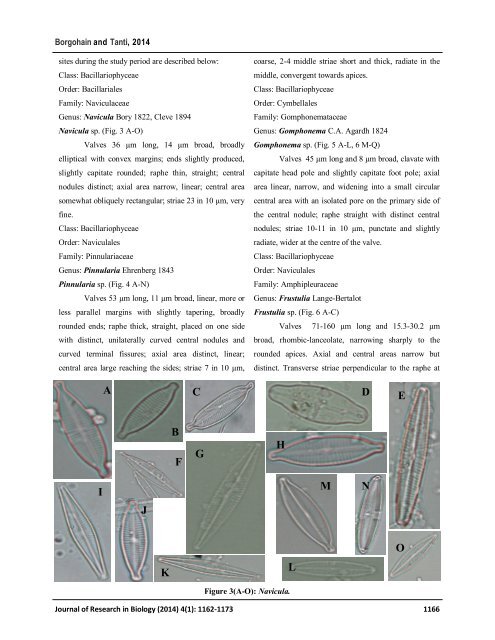Diversity of freshwater diatoms from few silica rich habitats of Assam, India
Diatoms are a ubiquitous class of phytoplankton of extreme importance for the biogeochemical cycling of minerals such as silica. Few places of Nagaon district of Assam, India viz., Jiajuri, Borhola, Thanajuri and Chapanala have been recognized as the highest silica zones by Geological Survey of India. No any research has been conducted to explore the diatom diversity at this important silica rich habitat. In the present investigation, the morphology and diversity of freshwater diatom species were investigated during May 2012 to April 2013. The samples were subjected to acid wash treatment followed by microscopic observations. Altogether 103 species of diatoms belonging to 20 genera were recorded. Occurrence of diatom varied in all the four different study sites. The dominant genera includes: Stauroneis, Kobayasiella, Eunotia, Pinnularia, Nitzschia, Gomphonema, Frustulia, Surirella, Achnanthes, Rhopalodia, Navicula, Synendra, Encyonema, Achnanthidium, Cymbella, Hippodonta, Tabularia, Actinella, Encyonopsis and Luticola. Notably, all the diatom species belonged to pennate type.
Diatoms are a ubiquitous class of phytoplankton of extreme importance for the biogeochemical cycling of minerals such as silica. Few places of Nagaon district of Assam, India viz., Jiajuri, Borhola, Thanajuri and Chapanala have been recognized as the highest silica zones by Geological Survey of India. No any research has been conducted to explore the diatom diversity at this important silica rich habitat. In the present investigation, the morphology and diversity of freshwater diatom species were investigated during May 2012 to April 2013. The samples were subjected to acid wash treatment followed by microscopic observations. Altogether 103 species of diatoms belonging to 20 genera were recorded. Occurrence of diatom varied in all the four different study sites. The dominant genera includes: Stauroneis, Kobayasiella, Eunotia, Pinnularia, Nitzschia, Gomphonema, Frustulia, Surirella, Achnanthes, Rhopalodia, Navicula, Synendra, Encyonema, Achnanthidium, Cymbella, Hippodonta, Tabularia, Actinella, Encyonopsis and Luticola. Notably, all the diatom species belonged to pennate type.
You also want an ePaper? Increase the reach of your titles
YUMPU automatically turns print PDFs into web optimized ePapers that Google loves.
Borgohain and Tanti, 2014<br />
sites during the study period are described below:<br />
Class: Bacillariophyceae<br />
Order: Bacillariales<br />
Family: Naviculaceae<br />
Genus: Navicula Bory 1822, Cleve 1894<br />
Navicula sp. (Fig. 3 A-O)<br />
Valves 36 µm long, 14 µm broad, broadly<br />
elliptical with convex margins; ends slightly produced,<br />
slightly capitate rounded; raphe thin, straight; central<br />
nodules distinct; axial area narrow, linear; central area<br />
somewhat obliquely rectangular; striae 23 in 10 µm, very<br />
fine.<br />
Class: Bacillariophyceae<br />
Order: Naviculales<br />
Family: Pinnulariaceae<br />
Genus: Pinnularia Ehrenberg 1843<br />
Pinnularia sp. (Fig. 4 A-N)<br />
Valves 53 µm long, 11 µm broad, linear, more or<br />
less parallel margins with slightly tapering, broadly<br />
rounded ends; raphe thick, straight, placed on one side<br />
with distinct, unilaterally curved central nodules and<br />
curved terminal fissures; axial area distinct, linear;<br />
central area large reaching the sides; striae 7 in 10 µm,<br />
coarse, 2-4 middle striae short and thick, radiate in the<br />
middle, convergent towards apices.<br />
Class: Bacillariophyceae<br />
Order: Cymbellales<br />
Family: Gomphonemataceae<br />
Genus: Gomphonema C.A. Agardh 1824<br />
Gomphonema sp. (Fig. 5 A-L, 6 M-Q)<br />
Valves 45 µm long and 8 µm broad, clavate with<br />
capitate head pole and slightly capitate foot pole; axial<br />
area linear, narrow, and widening into a small circular<br />
central area with an isolated pore on the primary side <strong>of</strong><br />
the central nodule; raphe straight with distinct central<br />
nodules; striae 10-11 in 10 µm, punctate and slightly<br />
radiate, wider at the centre <strong>of</strong> the valve.<br />
Class: Bacillariophyceae<br />
Order: Naviculales<br />
Family: Amphipleuraceae<br />
Genus: Frustulia Lange-Bertalot<br />
Frustulia sp. (Fig. 6 A-C)<br />
Valves 71-160 µm long and 15.3-30.2 µm<br />
broad, rhombic-lanceolate, narrowing sharply to the<br />
rounded apices. Axial and central areas narrow but<br />
distinct. Transverse striae perpendicular to the raphe at<br />
A<br />
C D E<br />
B<br />
F<br />
G<br />
H<br />
I<br />
J<br />
M<br />
N<br />
K<br />
Figure 3(A-O): Navicula.<br />
L<br />
O<br />
Journal <strong>of</strong> Research in Biology (2014) 4(1): 1162-1173 1166

















